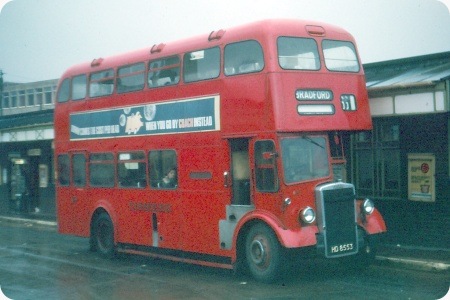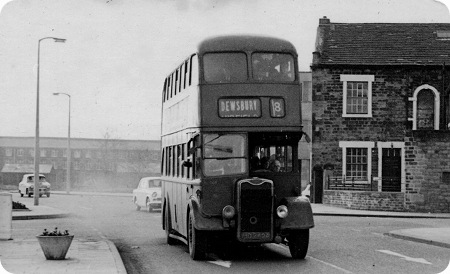
Yorkshire Woollen District Transport
1963
Leyland Titan PD2
Roe H63R
Now this gets interesting according to my book this is a 1950 Leyland Titan PD2/3 with a Roe H56R body. Well it is defiantly not a rear entrance that’s plain to see and the registration of just two letters I think came well before 1950. I think its time to get Googleing
Here is a result found on the SCT ’61 website the link takes you to a better photo of the same bus, the info found does make sense to me it is as follows.
“Yorkshire Woollen rebuilt a number of Leyland Tiger PS single deckers as double deck vehicles in the 1950s and 1960s. One such is HD8553, a PS2/5 given a Roe front entrance body in 1962 and numbered 699 – later renumbered 502 by YWD.
This bus and its brethren survived long enough to receive NBC livery.”
I think your history is wrong.
A large number of PS1s were rebodied. I saw one of the first which was painted "Poppy Red" in Frost Hill depot parked in the middle of the depot It looked terrible then. The new bodies were MCW Orion.
They weighed less after re-bodying than when original.
They were very noisy and cold as the new bodies were single skinned.
The photograph is one of a small batch of PS2s which were rebuilt much later. the chassis were rebuilt by YWD with new chassis sides, they originally had a bolt on chassis extension as the rules changed when they were originally built. I think there were only 8 rebuilt. A like number were sold to Yorkshire Traction for rebuilding the only difference was that the Yorkshire Traction rebuilds were reregistered. I never found out why.
E. Malone
I will investigate this further find my own information and get back, check with the ’Latest Comments’ page for any update.
Here are the details of a batch of six Leyland Tiger PS2/5 chassis that were re-bodied by Roe to H35/28F in 1963 Reg no HD 8551-4 and HD 8562-3 they went into service with fleet nos 697-700 and 708-9 respectively.
The above photograph is one of this batch and this information backs up the original article.
An extra piece of information I found is that the original Tigers were probable bodied by Willowbrook with a B38F body and were first built in 1950.
The PS1 chassis you mention were a batch of 24 originally built in 1948 the registrations are a bit haphazard but are late HD 7800s and very early 7900s the fleet nos are a bit the same but they all fall between 562-631. These were re-bodied by Metro-Cammell with H56R ‘Orion’ bodies in 1954-5.
Peter
Richard Malone is wrong about the colour. Poppy red only came in with NBC. The closest to the original colour was Post Office red. I know this from a YWD Fleetline I owned at one time.
There were 75 Brush bodied Leyland Tigers PS1s, fleet numbers 558-632 registration HD7841-7915. In 1954 12 of these were rebodied as double deckers with fleet numbers (562/75/7/97/8/9/603/11/3/4/6/20) with a weight of 6.8.1 tons. A further 12 were rebodied in 1955 as fleet numbers (570/4/83/7/8/96/618/24/7/8/30/1) with a weight of 6.7.0 tons. It is interesting to note that they weighed 6.9.1 tons as Tiger single deckers.
I own the only survivor of the original batch of Brush bodied Tiger PS1s fleet no 622 registration HD 7905 which can be seen here.
The Willowbrook/PS2s, 697-725, HD8551-79 (and OPD2s, 728-733, HD8710-5) were built in 1949. They were originally 27’6" long with B32F bodies these were then lengthened to 30′ B38F by Willowbrook between June 1954 and June 1955. Six were rebodied by Roe as H63F (697-700/8/9) for YWD a further nine went to YTC (701/4/6/7/10/1/2/4/6) in 1962, rebodied by Northern Counties as front entrance double deckers. (One of these still exists.)
Gordon Brooke
The subject of re registrations of bus rebuilds is an interesting one. I was always curios about the batch of Leyland PS2s that were rebodied as double deckers by both Yorkshire Traction and Yorkshire Woollen. The Y W D ones kept their old 2 letter HD marks yet the YTC ones were allocated new YHE marks of the time. Another example of these double standards concerns County Motors of Lepton owned by YTC, YWD and West Riding. In 1955 they had two elderly single deckers rebodied as double deckers. They wanted to give them new registrations but Huddersfield CBC would not allow this so they were transferred to Barnsley where they were given new marks of the time.
Philip Carlton
Difficult to tell from the photo if the width of this vehicle, was a PS2/5 7ft 6in or 8ft wide? The original batch of re-bodies, from PS1 chassis were certainly 7ft 6in Orions. When Birch Bros had some PD1’s re-bodied with Orions by MCW a year or so later, they were virtually identical even down to the destination display. Maybe the same drawings were used!
Chris Barker
01/01/14 – 09:14
I drove these buses in 1965 at this time I lived in Heckmondwyke and worked at Becklane Depot I remember the P duties they worked Mirfield Bradford 65 service they seemed to be sluggish pullers..
Jack
03/01/14 – 10:00
I would like to comment on the "Hales Cake" vehicle shown in Colin Shears yard. It is a Leyland TS7 and was East Midland Motor Services No10 BAL 610. In the 1950s I worked at EMMS Chesterfield workshops at this time after I left school and remember this vehicle well it was one of eighteen rebodied by Willowbrook in 1948 it looked far better in EMMS livery of biscuit cream and brown picture shown in Mikes afterlifes.
Jack
26/10/16 – 06:41
I remember the forward entrance versions of these rebodies on B and C services from Ossett to Fir Cottage in YWD red and cream and then NBC poppy red not bad for a bus built as a single decker in the late 1940s and still in service in the 1970s we cannot say that today, by the way I liked them as much as AEC Regent Vs.
David Parkin
27/10/16 – 08:17
To answer Chris Barker’s question from way back, the PS2/5 was 8 feet wide.
Peter Williamson
28/10/16 – 07:37
Peter W, thanks for your answer, I’m certain that these vehicles reverted to their original length of 27ft 6ins. upon rebuilding as double deckers, the seating capacity of 63 seems to support this. However, when they ran as single deckers, presumably they had drop frame extensions to enable the provision of luggage boots and then they were extended to 30ft length, still with drop frame rears, so was the chassis itself extended? When they became double deckers, a drop frame extension would have been of no use on a front entrance d/d but if it was simply removed, the rear overhang would have needed supporting somehow, I imagine new chassis frames were the only answer. Perhaps it might have been easier to rebody them as 30ft double deckers!
Chris Barker
31/03/17 – 15:37
The registration of just two letters I think came well before 1950.
Dewsbury didn’t reach HD 9999 until November 1953 – while it took until April 1960 for Bootle to reach EM 9999 and August 1960 for Rutland to reach FP 9999.
And nine Scottish counties didn’t reach 9999 with two letters before the year suffix system was introduced in 1964/5 – Buteshire famously only getting as far as SJ 2860.
Des Elmes
06/09/17 – 06:44
Chris Barker, I think you will find that NONE of the PS1 or 2’s owned by YWD had luggage boots. The emergency door was in the middle at the back on both those models.
Ron Lake



